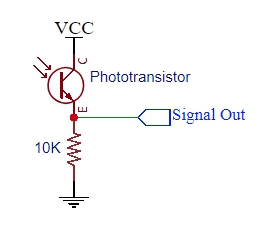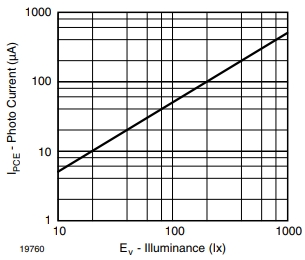
Reference: RBD-2892
Banner



Visible light to analog voltage converter for measuring the intensity of visible light.
 Security policy
Security policy
(edit with the Customer Reassurance module)
 Delivery policy
Delivery policy
(edit with the Customer Reassurance module)
 Return policy
Return policy
(edit with the Customer Reassurance module)
The TEMT6000 Ambient Light Sensor Module is a visible light to analog voltage converter for measuring the intensity of light.
The TEMT6000 was designed as an ambient light detector for automatically controlling the backlight dimming of cell phones, laptops, car dashboards and similar items. It can be used in many applications where it is desirable to measure the relative brightness of the light falling on the sensor.
The sensor is designed to mainly detect the light spectrum visible to the human eye with peak sensitivity at 570nm which is in the green spectrum. The full range spans 440nm to 800nm.
The sensor itself is a NPN phototransistor. Increased light intensity on the base of the transistor increases the current flowing through the transistor collector/emitter.

Schematic of TEMT6000 Module
The module includes a 10K resistor. The TEMT6000 sensor and the resistor form a voltage divider network as shown to the right. As light intensity increases, the current flow also increases. This causes the voltage drop across the 10K resistor to increase and so the voltage on the signal output increases towards Vcc.
The output voltage is fairly linear with the intensity of the illumination (lux) that is falling on the device. The range of reliable detection spans a low of 10 lux to a high of 1000 lux.
The analog output of the module is typically input into the analog input on a microcontroller where it can be measured and acted on. It works quite well for making relative measurements and determining if it is getting brighter or darker.
The module brings out the following connections.
1 x 3 Header
Minimum Vcc voltage can go lower than 3.0V since it just needs to be high enough to bias the NPN transistor and can be 1.2V or even lower. For use with an MCU, Vcc is typically kept the same as the MCU operating voltage.
The module ships with the male header strip loose. The header may be longer than 3-pins and can be snapped to the length required. The header can be soldered to the top or bottom of the module depending on the planned use or wires can be used to make the connections.
For breadboard use, we put the headers on the bottom. Soldering is easiest if the header is inserted into a breadboard to hold it in position during the soldering process.
These are nice little assemblies. The boards are high quality with gold plating.
The range on this sensor is about 10 lux to 1000 lux which is very dim to about what an overcast day is. At almost dark light levels, the sensor can struggle between determining dark vs a little less dark.
The chart to the right is from the datasheet. It shows current flowing through the sensor relative to the illuminance (lux). With a little math, the sensor can be made into an inexpensive lux meter.
The program below simply reads the output of the sensor every second and prints the raw reading and volts to the Serial Monitor window. It also runs a calculation based on the datasheet graph that converts the reading into a lux value.
The sensor is connected to analog pin A0, but this can be changed to any convenient analog input. Also be sure to provide power and ground. We are using 5V in this example. If using 3.3V, be sure to change AREF to 3.3.
/* TEMT6000 Light Meter Program Simple program to read the analog output of the TEMT6000 and display the raw reading, voltage and the calculated Lux We are connecting sensor to analog input A0, but this can be any analog pin. */ int const TEMP6000_PIN = A0; int const AREF = 5.0; // set for 5.0 or 3.3 depending on voltage of uC //=============================================================================== // Initialization //=============================================================================== void setup() { Serial.begin(9600); // Initialize serial comm } //=============================================================================== // Main //=============================================================================== void loop() { // The math is broken out into steps to make it easier to follow. float sensor_value = analogRead(TEMP6000_PIN); // Get raw sensor reading float volts = sensor_value * AREF / 1024.0; // Convert reading to voltage float amps = volts / 10000.0; // Convert to amps across 10K resistor float microamps = amps * 1000000.0; // Convert amps to microamps float lux = microamps * 2.0; // 2 microamps = 1 lux // All the math above can also be replaced with the following formula // assuming AREF is 5.0 volts. // float lux = sensor_value * 0.9765625; Serial.print ("Raw ADC data: "); Serial.print (sensor_value); Serial.print (" Volts: "); Serial.print (volts); Serial.print (" Lux: "); Serial.println (lux); delay(1000); // Take reading every second }
Specific References
Your review appreciation cannot be sent
Report comment
Report sent
Your report cannot be sent
Write your review
Review sent
Your review cannot be sent
Reference: RBD-2892
Reference: RBD-0995
Reference: RBD-1833
Reference: RBD-2237
Reference: RBD-2206
Reference: RBD-0382
Reference: RBD-0554
Reference: RBD-0222
Reference: RBD-2845
Reference: RBD-0722
Brand: Raspberry Pi Official
Reference: RBD-2444
Reference: RBD-2395
Reference: RBD-2227
Reference: RBD-0674
Reference: RBD-2654
Reference: RBD-2059

Visible light to analog voltage converter for measuring the intensity of visible light.
check_circle
check_circle